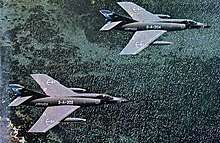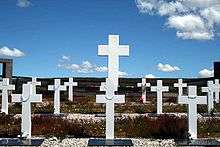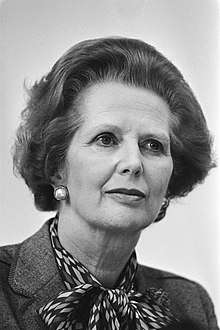Falklands War
The Falklands War (Spanish: Guerra de las Malvinas) was a 10-week undeclared war between Argentina and the United Kingdom in 1982 over two British dependent territories in the South Atlantic: the Falkland Islands and its territorial dependency, South Georgia and the South Sandwich Islands. The result of the war was a British victory.
The conflict began on 2 April, when Argentina invaded and occupied the Falkland Islands, followed by the invasion of South Georgia the next day. On 5 April, the British government dispatched a naval task force to engage the Argentine Navy and Air Force before making an amphibious assault on the islands. The conflict lasted 74 days and ended with an Argentine surrender on 14 June, returning the islands to British control. In total, 649 Argentine military personnel, 255 British military personnel, and three Falkland Islanders died during the hostilities.
The conflict was a major episode in the protracted dispute over the territories' sovereignty. Argentina asserted (and maintains) that the islands are Argentine territory,[4] and the Argentine government thus characterised its military action as the reclamation of its own territory. The British government regarded the action as an invasion of a territory that had been a Crown colony since 1841. Falkland Islanders, who have inhabited the islands since the early 19th century, are predominantly descendants of British settlers, and strongly favour British sovereignty. Neither state officially declared war, although both governments declared the Islands a war zone.
The conflict has had a strong effect in both countries and has been the subject of various books, articles, films, and songs. Patriotic sentiment ran high in Argentina, but the outcome prompted large protests against the ruling military government, hastening its downfall and the democratisation of the country. In the United Kingdom, the Conservative government, bolstered by the successful outcome, was re-elected with an increased majority the following year. The cultural and political effect of the conflict has been less in the UK than in Argentina, where it remains a common topic for discussion.[5]
Diplomatic relations between the United Kingdom and Argentina were restored in 1989 following a meeting in Madrid, at which the two governments issued a joint statement.[6] No change in either country's position regarding the sovereignty of the Falkland Islands was made explicit. In 1994, Argentina adopted a new Constitution,[7] which added the Falkland Islands as an Argentine Province by law [8]
Prelude
Failed diplomacy
In 1965, the United Nations called upon Argentina and the United Kingdom to reach a settlement of the sovereignty dispute. The UK Foreign and Commonwealth Office (FCO) regarded the islands as a nuisance and barrier to UK trade in South America, so, whilst confident of British sovereignty, was prepared to cede the islands to Argentina. When news of a proposed transfer broke in 1968, elements sympathetic with the plight of the islanders were able to organise an effective Parliamentary lobby to frustrate the FCO plans. Negotiations continued but in general failed to make meaningful progress; the islanders steadfastly refused to consider Argentine sovereignty on one side, whilst Argentina would not compromise over sovereignty on the other.[9] The FCO then sought to make the islands dependent on Argentina, hoping this would make the islanders more amenable to Argentine sovereignty. A Communications Agreement signed in 1971 created an airlink and later YPF, the Argentine oil company, was given a monopoly in the islands.
In 1980, a new Minister of State for Foreign Affairs, Nicholas Ridley, went to the Falklands trying to sell the islanders the benefits of a leaseback scheme, which met with strong opposition from the islanders. On returning to London in December 1980 he reported to parliament but was viciously attacked at what was seen as a sellout. (It was unlikely that leaseback could have succeeded since the British had sought a long-term lease of 99 years, whilst Argentina was pressing for a much shorter period of only 10 years.) At a private committee meeting that evening, it was reported that Ridley cried out: "If we don't do something, they will invade. And there is nothing we could do."[10]
The 1976 military coup and the Argentine junta
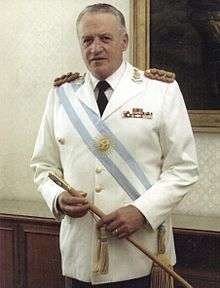
In the period leading up to the war—and, in particular, following the transfer of power between the military dictators General Jorge Rafael Videla and General Roberto Eduardo Viola late in March 1981—Argentina had been in the midst of devastating economic stagnation and large-scale civil unrest against the military junta that had been governing the country since 1976.[14][15]
In December 1981 there was a further change in the Argentine military regime, bringing to office a new junta headed by General Leopoldo Galtieri (acting president), Air Brigadier Basilio Lami Dozo and Admiral Jorge Anaya. Anaya was the main architect and supporter of a military solution for the long-standing claim over the islands,[16] calculating that the United Kingdom would never respond militarily.[17]
By opting for military action, the Galtieri government hoped to mobilise the long-standing patriotic feelings of Argentines towards the islands, and thus divert public attention from the country's chronic economic problems and the regime's ongoing human rights violations of the Dirty War.[18] Such action would also bolster its dwindling legitimacy. The newspaper La Prensa speculated in a step-by-step plan beginning with cutting off supplies to the islands, ending in direct actions late in 1982, if the UN talks were fruitless.[19]
The ongoing tension between the two countries over the islands increased on 19 March, when a group of Argentine scrap metal merchants (actually infiltrated by Argentine Marines) raised the Argentine flag at South Georgia Island, an act that would later be seen as the first offensive action in the war. The Royal Navy ice patrol vessel HMS Endurance was dispatched from Stanley to South Georgia on the 25th in response. The Argentine military junta, suspecting that the UK would reinforce its South Atlantic Forces, ordered the invasion of the Falkland Islands to be brought forward to 2 April.
The UK was initially taken by surprise by the Argentine attack on the South Atlantic islands, despite repeated warnings by Royal Navy captain Nicholas Barker (commander of the Endurance) and others. Barker believed that Defence Secretary John Nott's 1981 review (in which Nott described plans to withdraw the Endurance, the UK's only naval presence in the South Atlantic) had sent a signal to the Argentines that the UK was unwilling, and would soon be unable, to defend its territories and subjects in the Falklands.[20][21]
Argentine invasion
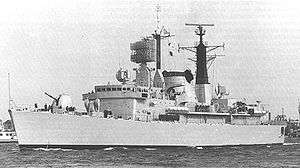
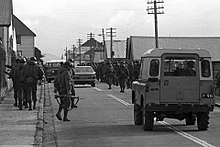
On 2 April 1982 Argentine forces mounted amphibious landings, known as Operation Rosario,[22] on the Falkland Islands.[23] The invasion was met with a nominal defence organised by the Falkland Islands' Governor Sir Rex Hunt, giving command to Major Mike Norman of the Royal Marines. The events of the invasion included the landing of Lieutenant Commander Guillermo Sanchez-Sabarots' Amphibious Commandos Group, the attack on Moody Brook barracks, the engagement between the troops of Hugo Santillan and Bill Trollope at Stanley, and the final engagement and surrender at Government House.
Initial British response
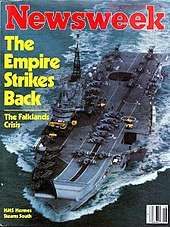
The British had already taken action prior to the 2 April invasion. In response to events on South Georgia, on 29 March, Ministers decided to send the Royal Fleet Auxiliary (RFA) Fort Austin south from the Mediterranean to support HMS Endurance, and the submarine HMS Spartan from Gibraltar, with HMS Splendid ordered south from Scotland the following day.[24]:75[25] Lord Carrington had wished to send a third submarine, but the decision was deferred due to concerns about the impact on operational commitments.[25] Coincidentally, on 26 March, the submarine HMS Superb left Gibraltar and it was assumed in the press it was heading south. There has since been speculation that the effect of those reports was to panic the Argentine junta into invading the Falklands before nuclear-powered submarines could be deployed.[25]
The following day, during a crisis meeting headed by the Prime Minister, Margaret Thatcher, the Chief of the Naval Staff, Admiral Sir Henry Leach, advised them that "Britain could and should send a task force if the islands are invaded". On 1 April, Leach sent orders to a Royal Navy force carrying out exercises in the Mediterranean to prepare to sail south. Following the invasion on 2 April, after an emergency meeting of the cabinet, approval was given to form a task force to retake the islands. This was backed in an emergency session of the House of Commons the next day.[26]
Word of the invasion first reached the UK from Argentine sources.[27] A Ministry of Defence operative in London had a short telex conversation with Governor Hunt's telex operator, who confirmed that Argentines were on the island and in control.[27][28] Later that day, BBC journalist Laurie Margolis spoke with an islander at Goose Green via amateur radio, who confirmed the presence of a large Argentine fleet and that Argentine forces had taken control of the island.[27] British military operations in the Falklands War were given the codename Operation Corporate, and the commander of the task force was Admiral Sir John Fieldhouse. Operations lasted from 1 April 1982 to 20 June 1982.[29]
On 6 April, the British Government set up a War Cabinet to provide day-to-day political oversight of the campaign.[30] This was the critical instrument of crisis management for the British with its remit being to "keep under review political and military developments relating to the South Atlantic, and to report as necessary to the Defence and Overseas Policy Committee". The War Cabinet met at least daily until it was dissolved on 12 August. Although Margaret Thatcher is described as dominating the War Cabinet, Lawrence Freedman notes in the Official History of the Falklands Campaign that she did not ignore opposition or fail to consult others. However, once a decision was reached she "did not look back".[30]
United Nations Security Council Resolution 502
On 31 March 1982, the Argentine ambassador to the UN, Eduardo Roca, tried garnering support against a British military build-up designed to thwart earlier UN resolutions calling for both countries to resolve their Falklands dispute through discussion.[24]:134 He did this because Argentina, based on inadequate intelligence gathering, was convinced a British task force was already on its way to the South Atlantic, and because of Britain's threat to use HMS Endurance to remove the scrap-metal workers from South Georgia. Any Argentine military action could then be justified as trying to counter Britain's use of force to evade complying with an earlier UN resolution. This Argentine approach to portray Britain as the aggressor came to nothing.
On 1 April, London told the UK ambassador to the UN, Sir Anthony Parsons, that an invasion was imminent and he should call an urgent meeting of the Security Council to get a favourable resolution against Argentina.[31] Parsons had to get nine affirmative votes from the 15 Council members (not a simple majority) and to avoid a blocking vote from any of the other four permanent members. The meeting took place at 11.00am on 3 April, New York time (4.00pm in London). Resolution 502 was adopted by 10 to 1, with 4 abstentions.[32][33][34] It said the UN was:
- Deeply disturbed at reports of an invasion on 2 April 1982 by armed forces of Argentina;
- Determining that there exists a breach of the peace in the region of the Falkland Islands (Islas Malvinas),
- Demands an immediate cessation of hostilities;
- Demands an immediate withdrawal of all Argentine forces from the Falkland Islands (Islas Malvinas)
- Calls on the Governments of Argentina and the United Kingdom to seek a diplomatic solution to their differences and to respect fully the purposes and principles of the Charter of the United Nations.
This was a significant win for the UK, giving it the upper hand diplomatically. The draft resolution Parsons submitted had avoided any reference to the sovereignty dispute, that might have worked against the UK: instead it focused on Argentina's breach of Chapter VII of the UN Charter which forbids the threat or use of force to settle disputes.[35] The resolution called for the removal only of Argentine forces: this freed Britain to retake the islands militarily, if Argentina did not leave, by exercising its right to self-defence, that was allowed under the UN Charter.[24]:141
Position of third-party countries
The UK received further political support from member countries of the Commonwealth of Nations and the European Economic Community. Australia, Canada, and New Zealand withdrew their diplomats from Buenos Aires.[36] The EEC also provided economic support by imposing economic sanctions on Argentina.
Argentina itself was politically backed by a majority of countries in Latin America (though, notably, not Chile). Some members of the Non-Aligned Movement also backed Argentina's position.[37]
The New Zealand government expelled the Argentine ambassador following the invasion. The Prime Minister, Robert Muldoon, was in London when the war broke out[38] and in an opinion piece published in The Times he said: "The military rulers of Argentina must not be appeased … New Zealand will back Britain all the way." Broadcasting on the BBC World Service, he told the Falkland Islanders: "This is Rob Muldoon. We are thinking of you and we are giving our full and total support to the British Government in its endeavours to rectify this situation and get rid of the people who have invaded your country.”[39] On 20 May 1982, he announced that New Zealand would make HMNZS Canterbury, a Leander-class frigate, available for use where the British thought fit to release a Royal Navy vessel for the Falklands.[40] In the House of Commons afterwards, Margaret Thatcher said: “…the New Zealand Government and people have been absolutely magnificent in their support for this country [and] the Falkland Islanders, for the rule of liberty and of law".[39][41]
The French president, François Mitterrand, declared an embargo on French arms sales and assistance to Argentina.[42] In addition, France allowed UK aircraft and warships use of its port and airfield facilities at Dakar in Senegal[43] and France provided dissimilar aircraft training so that Harrier pilots could train against the French aircraft used by Argentina.[44] French intelligence also cooperated with Britain to prevent Argentina from obtaining more Exocet missiles on the international market.[45] In a 2002 interview, and in reference to this support, John Nott, the then British Defence Secretary, had described France as Britain's 'greatest ally'. In 2012, it came to light that while this support was taking place, a French technical team, employed by Dassault and already in Argentina, remained there throughout the war despite the presidential decree. The team had provided material support to the Argentines, identifying and fixing faults in Exocet missile launchers. John Nott said he had known the French team was there but said its work was thought not to be of any importance. An adviser to the then French government denied any knowledge at the time that the technical team was there. In contrast, a then French intelligence officer maintained he knew the team was there but it was in an intelligence-gathering capacity. John Nott, when asked if he regretted his earlier praise of the French, said he thought the French were "duplicitous", and "always have been".[46]
The Sierra Leone government allowed British task force ships to refuel at Freetown.[47] VC10 transport aircraft landed at Banjul in The Gambia while flying between the UK and Ascension Island.[43]
Declassified cables show the U.S. felt that Thatcher had not considered diplomatic options, and also feared that a protracted conflict could draw the Soviet Union on Argentina's side,[48] and initially tried to mediate an end to the conflict through "shuttle diplomacy". However, when Argentina refused the U.S. peace overtures, U.S. Secretary of State Alexander Haig announced that the United States would prohibit arms sales to Argentina and provide material support for British operations. Both houses of the U.S. Congress passed resolutions supporting the U.S. action siding with the United Kingdom.[49]
The U.S. provided the United Kingdom with Sidewinder missiles for use by the Harrier jets.[50][51] President Ronald Reagan approved the Royal Navy's request to borrow the Sea Harrier-capable amphibious assault ship USS Iwo Jima (LPH-2) if the British lost an aircraft carrier. The United States Navy developed a plan to help the British man the ship with American military contractors, likely retired sailors with knowledge of Iwo Jima's systems.[52]
Peru attempted to purchase 12 Exocet missiles from France to be delivered to Argentina, in a failed secret operation.[53][54]
Chile gave support to the UK in the form of intelligence about the Argentine military and early warning intelligence on Argentine air movements.[55][56] Throughout the war, Argentina was afraid of a Chilean military intervention in Patagonia and kept some of its best mountain regiments away from the Falklands near the Chilean border as a precaution.[57] The Chilean government also allowed the United Kingdom to requisition the refueling vessel RFA Tidepool, which Chile had recently purchased and which had arrived at Arica in Chile on 4 April. The ship left port soon afterwards, bound for Ascension Island through the Panama Canal and stopping at Curaçao en route.[58][59][60]
According to the book Operation Israel, advisers from Israel Aerospace Industries were already in Argentina and continued their work during the conflict. The book also claims that Israel sold weapons and drop tanks in a secret operation in Peru.[61][62] Peru also openly sent "Mirages, pilots and missiles" to Argentina during the war.[63] Peru had earlier transferred ten Hercules transport planes to Argentina soon after the British Task Force had set sail in April 1982.[64] Nick van der Bijl records that, after the Argentine defeat at Goose Green, Venezuela and Guatemala offered to send paratroopers to the Falklands.[65] Through Libya, under Muammar Gaddafi, Argentina received 20 launchers and 60 SA-7 missiles, as well as machine guns, mortars and mines; all in all, the load of four trips of two Boeing 707s of the AAF, refuelled in Recife with the knowledge and consent of the Brazilian government.[66] Some of these clandestine logistics operations were mounted by the Soviet Union.[67]
British task force
_1982.jpg)
_underway_c1981.jpg)
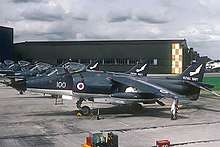
The British government had no contingency plan for an invasion of the islands, and the task force was rapidly put together from whatever vessels were available.[68] The nuclear-powered submarine Conqueror set sail from France on 4 April, whilst the two aircraft carriers Invincible and Hermes, in the company of escort vessels, left Portsmouth only a day later.[26] On its return to Southampton from a world cruise on 7 April, the ocean liner SS Canberra was requisitioned and set sail two days later with 3 Commando Brigade aboard.[26] The ocean liner Queen Elizabeth 2 was also requisitioned and left Southampton on 12 May with 5th Infantry Brigade on board.[26] The whole task force eventually comprised 127 ships: 43 Royal Navy vessels, 22 Royal Fleet Auxiliary ships and 62 merchant ships.[68]
The retaking of the Falkland Islands was considered extremely difficult. The chances of a British counter-invasion succeeding were assessed by the US Navy, according to historian Arthur L. Herman, as "a military impossibility".[69] Firstly, the British were significantly constrained by the disparity in deployable air cover.[70] The British had 42 aircraft (28 Sea Harriers and 14 Harrier GR.3s) available for air combat operations,[71] against approximately 122 serviceable jet fighters, of which about 50 were used as air superiority fighters and the remainder as strike aircraft, in Argentina's air forces during the war.[72] Crucially, the British lacked airborne early warning and control (AEW) aircraft. Planning also considered the Argentine surface fleet and the threat posed by Exocet-equipped vessels or the two Type 209 submarines.[73]
By mid-April, the Royal Air Force had set up the airbase of RAF Ascension Island, co-located with Wideawake Airfield on the mid-Atlantic British overseas territory of Ascension Island, including a sizeable force of Avro Vulcan B Mk 2 bombers, Handley Page Victor K Mk 2 refuelling aircraft, and McDonnell Douglas Phantom FGR Mk 2 fighters to protect them. Meanwhile, the main British naval task force arrived at Ascension to prepare for active service. A small force had already been sent south to recapture South Georgia.
Encounters began in April; the British Task Force was shadowed by Boeing 707 aircraft of the Argentine Air Force during their travel to the south.[74] Several of these flights were intercepted by Sea Harriers outside the British-imposed Total Exclusion Zone; the unarmed 707s were not attacked because diplomatic moves were still in progress and the UK had not yet decided to commit itself to armed force. On 23 April, a Brazilian commercial Douglas DC-10 from VARIG Airlines en route to South Africa was intercepted by British Harriers who visually identified the civilian plane.[75]
Recapture of South Georgia and the attack on Santa Fe
The South Georgia force, Operation Paraquet, under the command of Major Guy Sheridan RM, consisted of Marines from 42 Commando, a troop of the Special Air Service (SAS) and Special Boat Service (SBS) troops who were intended to land as reconnaissance forces for an invasion by the Royal Marines. All were embarked on RFA Tidespring. First to arrive was the Churchill-class submarine HMS Conqueror on 19 April, and the island was over-flown by a radar-mapping Handley Page Victor on 20 April.
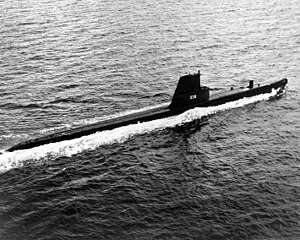
The first landings of SAS troops took place on 21 April, but—with the southern hemisphere autumn setting in—the weather was so bad that their landings and others made the next day were all withdrawn after two helicopters crashed in fog on Fortuna Glacier. On 23 April, a submarine alert was sounded and operations were halted, with Tidespring being withdrawn to deeper water to avoid interception. On 24 April, the British forces regrouped and headed in to attack.
On 25 April, after resupplying the Argentine garrison in South Georgia, the submarine ARA Santa Fe was spotted on the surface[76] by a Westland Wessex HAS Mk 3 helicopter from HMS Antrim, which attacked the Argentine submarine with depth charges. HMS Plymouth launched a Westland Wasp HAS.Mk.1 helicopter, and HMS Brilliant launched a Westland Lynx HAS Mk 2. The Lynx launched a torpedo, and strafed the submarine with its pintle-mounted general purpose machine gun; the Wessex also fired on Santa Fe with its GPMG. The Wasp from HMS Plymouth as well as two other Wasps launched from HMS Endurance fired AS-12 ASM antiship missiles at the submarine, scoring hits. Santa Fe was damaged badly enough to prevent her from diving. The crew abandoned the submarine at the jetty at King Edward Point on South Georgia.
With Tidespring now far out to sea, and the Argentine forces augmented by the submarine's crew, Major Sheridan decided to gather the 76 men he had and make a direct assault that day. After a short forced march by the British troops and a naval bombardment demonstration by two Royal Navy vessels (Antrim and Plymouth), the Argentine forces surrendered without resistance. The message sent from the naval force at South Georgia to London was, "Be pleased to inform Her Majesty that the White Ensign flies alongside the Union Jack in South Georgia. God Save the Queen." The Prime Minister, Margaret Thatcher, broke the news to the media, telling them to "Just rejoice at that news, and congratulate our forces and the Marines!"[77]
Black Buck raids
On 1 May British operations on the Falklands opened with the "Black Buck 1" attack (of a series of five) on the airfield at Stanley. A Vulcan bomber from Ascension flew on an 8,000-nautical-mile (15,000 km; 9,200 mi) round trip dropping conventional bombs across the runway at Stanley and back to Ascension. The mission required repeated refuelling, and required several Victor K2 tanker aircraft operating in concert, including tanker-to-tanker refuelling. The overall effect of the raids on the war is difficult to determine, and the raids consumed precious tanker resources from Ascension,[78] but also prevented Argentina from stationing fast jets on the islands.
Historian Lawrence Freedman, who was given access to official sources, comments that the significance of the Vulcan raids remains controversial.[79] Although taking pressure off the small Sea Harrier force, the raids were costly and used a great deal of resources. The single hit in the centre of the runway was probably the best that could have been expected but it did reduce the capability of the runway to operate fast jets and caused the Argentine air force to deploy Mirage III to defend the capital.[80] Argentine sources confirm that the Vulcan raids influenced Argentina to withdraw some of its Mirage IIIs from Southern Argentina to the Buenos Aires Defence Zone.[81][82][83] This dissuasive effect was watered down when British officials made clear that there would not be strikes on air bases in Argentina.[84] The raids were later dismissed as propaganda by Falklands veteran Commander Nigel Ward.[85]
Of the five Black Buck raids, three were against Stanley Airfield, with the other two anti-radar missions using Shrike anti-radiation missiles.
Escalation of the air war
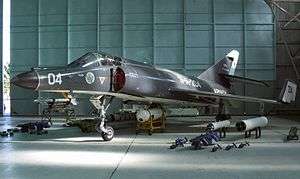
The Falklands had only three airfields. The longest and only paved runway was at the capital, Stanley, and even that was too short to support fast jets (although an arrestor gear was fitted in April to support Skyhawks). Therefore, the Argentines were forced to launch their major strikes from the mainland, severely hampering their efforts at forward staging, combat air patrols, and close air support over the islands. The effective loiter time of incoming Argentine aircraft was low, and they were later compelled to overfly British forces in any attempt to attack the islands.
The first major Argentine strike force comprised 36 aircraft (A-4 Skyhawks, IAI Daggers, English Electric Canberras, and Mirage III escorts), and was sent on 1 May, in the belief that the British invasion was imminent or landings had already taken place. Only a section of Grupo 6 (flying IAI Dagger aircraft) found ships, which were firing at Argentine defences near the islands. The Daggers managed to attack the ships and return safely. This greatly boosted morale of the Argentine pilots, who now knew they could survive an attack against modern warships, protected by radar ground clutter from the islands and by using a late pop up profile. Meanwhile, other Argentine aircraft were intercepted by BAE Sea Harriers operating from HMS Invincible. A Dagger[86] and a Canberra were shot down.
Combat broke out between Sea Harrier FRS Mk 1 fighters of No. 801 Naval Air Squadron and Mirage III fighters of Grupo 8. Both sides refused to fight at the other's best altitude, until two Mirages finally descended to engage. One was shot down by an AIM-9L Sidewinder air-to-air missile (AAM), while the other escaped but was damaged and without enough fuel to return to its mainland air base. The plane made for Stanley, where it fell victim to friendly fire from the Argentine defenders.[87]
As a result of this experience, Argentine Air Force staff decided to employ A-4 Skyhawks and Daggers only as strike units, the Canberras only during the night, and Mirage IIIs (without air refuelling capability or any capable AAM) as decoys to lure away the British Sea Harriers. The decoying would be later extended with the formation of the Escuadrón Fénix, a squadron of civilian jets flying 24 hours a day, simulating strike aircraft preparing to attack the fleet. On one of these flights on 7 June, an Air Force Learjet 35A was shot down, killing the squadron commander, Vice Commodore Rodolfo De La Colina, the highest-ranking Argentine officer to die in the war.[88][89]
Stanley was used as an Argentine strongpoint throughout the conflict. Despite the Black Buck and Harrier raids on Stanley airfield (no fast jets were stationed there for air defence) and overnight shelling by detached ships, it was never out of action entirely. Stanley was defended by a mixture of surface-to-air missile (SAM) systems (Franco-German Roland and British Tigercat) and Swiss-built Oerlikon 35 mm twin anti-aircraft cannons. Lockheed Hercules transport night flights brought supplies, weapons, vehicles, and fuel, and airlifted out the wounded up until the end of the conflict.
The only Argentine Hercules shot down by the British was lost on 1 June when TC-63 was intercepted by a Sea Harrier in daylight[90][91] when it was searching for the British fleet north-east of the islands after the Argentine Navy retired its last SP-2H Neptune due to airframe attrition.
Various options to attack the home base of the five Argentine Étendards at Río Grande were examined and discounted (Operation Mikado), subsequently five Royal Navy submarines lined up, submerged, on the edge of Argentina's 12-nautical-mile (22 km; 14 mi) territorial limit to provide early warning of bombing raids on the British task force.[92]
Sinking of ARA General Belgrano
.jpg)
Two British naval task forces (one of surface vessels and one of submarines) and the Argentine fleet were operating in the neighbourhood of the Falklands and soon came into conflict. The first naval loss was the Second World War-vintage Argentine light cruiser ARA General Belgrano. The nuclear-powered submarine HMS Conqueror sank General Belgrano on 2 May. Three hundred and twenty-three members of General Belgrano's crew died in the incident. More than 700 men were rescued from the open ocean despite cold seas and stormy weather. The losses from General Belgrano totalled nearly half of the Argentine deaths in the Falklands conflict, and the loss of the ship hardened the stance of the Argentine government.
Regardless of controversies over the sinking—including disagreement about the exact nature of the maritime exclusion zone and whether General Belgrano had been returning to port at the time of the sinking—it had a crucial strategic effect: the elimination of the Argentine naval threat. After her loss, the entire Argentine fleet, with the exception of the diesel-powered submarine ARA San Luis,[76] returned to port and did not leave again during the fighting. The two escorting destroyers and the battle group centred on the aircraft carrier ARA Veinticinco de Mayo both withdrew from the area, ending the direct threat to the British fleet that their pincer movement had represented.
However, settling the controversy in 2003, the ship's captain Hector Bonzo confirmed that General Belgrano had actually been manoeuvering, not "sailing away" from the exclusion zone, and had orders to sink "any British ship he could find". Further, Captain Bonzo stated that any suggestion that HMS Conqueror's actions were a "betrayal" was utterly wrong; rather, the submarine carried out its duties according to the accepted rules of war.[93]
In a separate incident later that night, British forces engaged an Argentine patrol gunboat, the ARA Alferez Sobral, that was searching for the crew of the Argentine Air Force Canberra light bomber shot down on 1 May. Two Royal Navy Lynx helicopters fired four Sea Skua missiles at her. Badly damaged and with eight crew dead, Alferez Sobral managed to return to Puerto Deseado two days later. The Canberra's crew were never found.
Sinking of HMS Sheffield
.jpg)
On 4 May, two days after the sinking of General Belgrano, the British lost the Type 42 destroyer HMS Sheffield to fire following an Exocet missile strike from the Argentine 2nd Naval Air Fighter/Attack Squadron.
Sheffield had been ordered forward with two other Type 42s to provide a long-range radar and medium-high altitude missile picket far from the British carriers. She was struck amidships, with devastating effect, ultimately killing 20 crew members and severely injuring 24 others. The ship was abandoned several hours later, gutted and deformed by the fires that continued to burn for six more days. She finally sank outside the Maritime Exclusion Zone on 10 May.
The incident is described in detail by Admiral Sandy Woodward in his book One Hundred Days, in Chapter One. Woodward was a former commanding officer of Sheffield.[94] The destruction of Sheffield (the first Royal Navy ship sunk in action since the Second World War) had a profound impact on the British public, bringing home the fact that the "Falklands Crisis", as the BBC News put it, was now an actual "shooting war".
Diplomatic activity
The tempo of operations increased throughout the first half of May as the United Nations' attempts to mediate a peace were rejected by the Argentines. The final British negotiating position was presented to Argentina by UN Secretary General Pérez de Cuéllar on 18 May 1982. In it, the British abandoned their previous "red-line" that British administration of the islands should be restored on the withdrawal of Argentine forces, as supported by United Nations Security Council Resolution 502.
Instead, it proposed a UN administrator should supervise the mutual withdrawal of both Argentine and British forces, then govern the islands in consultation with the representative institutions of the islands, including Argentines, although no Argentines lived there. Reference to "self-determination" of the islanders was dropped and the British proposed that future negotiations over the sovereignty of the islands should be conducted by the UN.[95]
Special forces operations
Given the threat to the British fleet posed by the Étendard-Exocet combination, plans were made to use C-130s to fly in some SAS troops to attack the home base of the five Étendards at Río Grande, Tierra del Fuego. The operation was codenamed "Mikado". The operation was later scrapped, after acknowledging that its chances of success were limited, and replaced with a plan to use the submarine HMS Onyx to drop SAS operatives several miles offshore at night for them to make their way to the coast aboard rubber inflatables and proceed to destroy Argentina's remaining Exocet stockpile.[96]
An SAS reconnaissance team was dispatched to carry out preparations for a seaborne infiltration. A Westland Sea King helicopter carrying the assigned team took off from HMS Invincible on the night of 17 May, but bad weather forced it to land 50 miles (80 km) from its target and the mission was aborted.[97] The pilot flew to Chile, landed south of Punta Arenas, and dropped off the SAS team. The helicopter's crew of three then destroyed the aircraft, surrendered to Chilean police on 25 May, and were repatriated to the UK after interrogation. The discovery of the burnt-out helicopter attracted considerable international attention. Meanwhile, the SAS team crossed the border and penetrated into Argentina, but cancelled their mission after the Argentines suspected an SAS operation and deployed some 2,000 troops to search for them. The SAS men were able to return to Chile, and took a civilian flight back to the UK.[98]
On 14 May the SAS carried out a raid on Pebble Island on the Falklands, where the Argentine Navy had taken over a grass airstrip map for FMA IA 58 Pucará light ground-attack aircraft and Beechcraft T-34 Mentors, which resulted in the destruction of several aircraft.[nb 1]
Air and sea battles
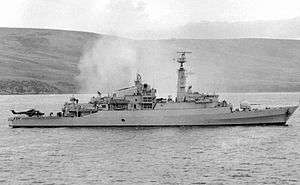
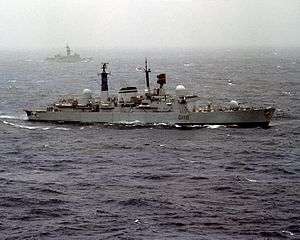
At sea, the limitations of the British ships' anti-aircraft defences was demonstrated in the sinking of HMS Ardent on 21 May, HMS Antelope (on 24 May when attempts to defuse bombs failed), and the loss of the cargo of helicopters, runway-building equipment and tents on MV Atlantic Conveyor (struck by two AM39 Exocets) on 25 May. The loss of all but one of the Chinook helicopters being carried by the Atlantic Conveyor as well as their maintenance equipment and facilities was a severe blow from a logistical perspective.
Also lost on 21 May was HMS Coventry, a sister to Sheffield, whilst in company with HMS Broadsword after being ordered to act as a decoy to draw away Argentine aircraft from other ships at San Carlos Bay.[99] HMS Argonaut and HMS Brilliant were moderately damaged.[100] However, many British ships escaped being sunk because of limitations imposed by circumstances on Argentine pilots. To avoid the highest concentration of British air defences, Argentine pilots released bombs at very low altitude, and hence those bomb fuzes did not have sufficient time to arm before impact. The low release of the retarded bombs (some of which the British had sold to the Argentines years earlier) meant that many never exploded, as there was insufficient time in the air for them to arm themselves.[101] The pilots would have been aware of this—but due to the high concentration required to avoid SAMs, Anti-Aircraft Artillery (AAA), and British Sea Harriers, many failed to climb to the necessary release point. The Argentine forces solved the problem by fitting improvised retarding devices, allowing the pilots to effectively employ low-level bombing attacks on 8 June.
In his autobiographical account of the Falklands War, Admiral Woodward blamed the BBC World Service for disclosing information that led the Argentines to change the retarding devices on the bombs. The World Service reported the lack of detonations after receiving a briefing on the matter from a Ministry of Defence official. He describes the BBC as being more concerned with being "fearless seekers after truth" than with the lives of British servicemen.[102] Colonel 'H'. Jones levelled similar accusations against the BBC after they disclosed the impending British attack on Goose Green by 2 Para.
Thirteen bombs hit British ships without detonating.[103] Lord Craig, the retired Marshal of the Royal Air Force, is said to have remarked: "Six better fuses and we would have lost"[104] although Ardent and Antelope were both lost despite the failure of bombs to explode, and Argonaut was out of action. The fuzes were functioning correctly, and the bombs were simply released from too low an altitude.[102][105] The Argentines lost 22 aircraft in the attacks.[nb 2]
The Argentine Navy used their last AM39 Exocet missile attempting to attack HMS Invincible on 30 May. There are Argentine claims that the missile struck;[106][107] however, the British have denied this, some citing that HMS Avenger shot it down.[108][109] When Invincible returned to the UK after the war, she showed no signs of missile damage.
Land battles
San Carlos – Bomb Alley
During the night of 21 May, the British Amphibious Task Group under the command of Commodore Michael Clapp (Commodore, Amphibious Warfare – COMAW) mounted Operation Sutton, the amphibious landing on beaches around San Carlos Water,[nb 3] on the northwestern coast of East Falkland facing onto Falkland Sound. The bay, known as Bomb Alley by British forces, was the scene of repeated air attacks by low-flying Argentine jets.[110][111]
The 4,000 men of 3 Commando Brigade were put ashore as follows: 2nd Battalion, Parachute Regiment (2 Para) from the RORO ferry Norland and 40 Commando Royal Marines from the amphibious ship HMS Fearless were landed at San Carlos (Blue Beach), 3rd Battalion, Parachute Regiment (3 Para) from the amphibious ship HMS Intrepid was landed at Port San Carlos (Green Beach) and 45 Commando from RFA Stromness was landed at Ajax Bay (Red Beach). Notably, the waves of eight LCUs and eight LCVPs were led by Major Ewen Southby-Tailyour, who had commanded the Falklands detachment NP8901 from March 1978 to 1979. 42 Commando on the ocean liner SS Canberra was a tactical reserve. Units from the Royal Artillery, Royal Engineers, etc. and armoured reconnaissance vehicles were also put ashore with the landing craft, the Round Table class LSL and mexeflote barges. Rapier missile launchers were carried as underslung loads of Sea Kings for rapid deployment.
By dawn the next day, they had established a secure beachhead from which to conduct offensive operations. From there, Brigadier Julian Thompson's plan was to capture Darwin and Goose Green before turning towards Port Stanley. Now, with the British troops on the ground, the South Air Force (Argentina) began the night bombing campaign against them using Canberra bomber planes until the last day of the war (14 June).
Goose Green
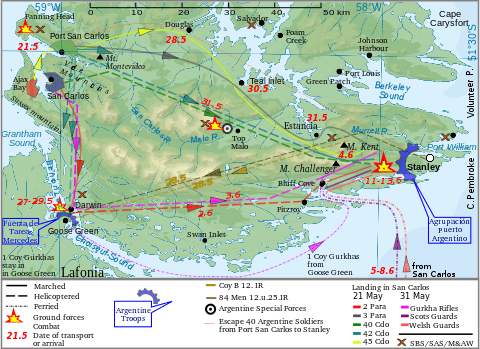
From early on 27 May until 28 May, 2 Para (approximately 500 men), with naval gunfire support from HMS Arrow[112] and artillery support from 8 Commando Battery, Royal Artillery, approached and attacked Darwin and Goose Green, which was held by the Argentine 12th Infantry Regiment. After a tough struggle that lasted all night and into the next day, the British won the battle; in all, 17 British and 47 Argentine soldiers were killed. A total of 961 Argentine troops (including 202 Argentine Air Force personnel of the Condor airfield) were taken prisoner.
The BBC announced the taking of Goose Green on the BBC World Service before it had actually happened. It was during this attack that Lieutenant Colonel H. Jones, the commanding officer of 2 Para, was killed at the head of his battalion while charging into the well-prepared Argentine positions. He was posthumously awarded the Victoria Cross.
With the sizeable Argentine force at Goose Green out of the way, British forces were now able to break out of the San Carlos beachhead. On 27 May, men of 45 Cdo and 3 Para started a loaded march across East Falkland towards the coastal settlement of Teal Inlet.
Special forces on Mount Kent
Meanwhile, 42 Commando prepared to move by helicopter to Mount Kent.[nb 4] Unknown to senior British officers, the Argentine generals were determined to tie down the British troops in the Mount Kent area, and on 27 and 28 May they sent transport aircraft loaded with Blowpipe surface-to-air missiles and commandos (602nd Commando Company and 601st National Gendarmerie Special Forces Squadron) to Stanley. This operation was known as Autoimpuesta ("Self-determination initiative").
For the next week, the SAS and the Mountain and Arctic Warfare Cadre (M&AWC) of 3 Commando Brigade waged intense patrol battles with patrols of the volunteers' 602nd Commando Company under Major Aldo Rico, normally second in Command of the 22nd Mountain Infantry Regiment. Throughout 30 May, Royal Air Force Harriers were active over Mount Kent. One of them, Harrier XZ963, flown by Squadron Leader Jerry Pook—in responding to a call for help from D Squadron, attacked Mount Kent's eastern lower slopes, and that led to its loss through small-arms fire. Pook was subsequently awarded the Distinguished Flying Cross.[113] On 31 May, the M&AWC defeated Argentine Special Forces at the skirmish at Top Malo House. A 13-strong Argentine Army Commando detachment (Captain José Vercesi's 1st Assault Section, 602nd Commando Company) found itself trapped in a small shepherd's house at Top Malo. The Argentine commandos fired from windows and doorways and then took refuge in a stream bed 200 metres (700 ft) from the burning house. Completely surrounded, they fought 19 M&AWC marines under Captain Rod Boswell for 45 minutes until, with their ammunition almost exhausted, they elected to surrender.
Three Cadre members were badly wounded. On the Argentine side, there were two dead, including Lieutenant Ernesto Espinoza and Sergeant Mateo Sbert (who were posthumously decorated for their bravery). Only five Argentines were left unscathed. As the British mopped up Top Malo House, Lieutenant Fraser Haddow's M&AWC patrol came down from Malo Hill, brandishing a large Union Flag. One wounded Argentine soldier, Lieutenant Horacio Losito, commented that their escape route would have taken them through Haddow's position.
601st Commando tried to move forward to rescue 602nd Commando Company on Estancia Mountain. Spotted by 42 Commando, they were engaged with L16 81mm mortars and forced to withdraw to Two Sisters mountain. The leader of 602nd Commando Company on Estancia Mountain realised his position had become untenable and after conferring with fellow officers ordered a withdrawal.[114]
The Argentine operation also saw the extensive use of helicopter support to position and extract patrols; the 601st Combat Aviation Battalion also suffered casualties. At about 11:00 am on 30 May, an Aérospatiale SA 330 Puma helicopter was brought down by a shoulder-launched FIM-92 Stinger surface-to-air missile (SAM) fired by the SAS in the vicinity of Mount Kent. Six Argentine National Gendarmerie Special Forces were killed and eight more wounded in the crash.[115]
As Brigadier Thompson commented, "It was fortunate that I had ignored the views expressed by Northwood HQ that reconnaissance of Mount Kent before insertion of 42 Commando was superfluous. Had D Squadron not been there, the Argentine Special Forces would have caught the Commando before de-planing and, in the darkness and confusion on a strange landing zone, inflicted heavy casualties on men and helicopters."[116]
Bluff Cove and Fitzroy
By 1 June, with the arrival of a further 5,000 British troops of the 5th Infantry Brigade, the new British divisional commander, Major General Jeremy Moore RM, had sufficient force to start planning an offensive against Stanley. During this build-up, the Argentine air assaults on the British naval forces continued, killing 56. Of the dead, 32 were from the Welsh Guards on RFA Sir Galahad and RFA Sir Tristram on 8 June. According to Surgeon-Commander Rick Jolly of the Falklands Field Hospital, more than 150 men suffered burns and injuries of some kind in the attack, including, famously, Simon Weston.[117]
The Guards were sent to support an advance along the southern approach to Stanley. On 2 June, a small advance party of 2 Para moved to Swan Inlet house in a number of Army Westland Scout helicopters. Telephoning ahead to Fitzroy, they discovered that the area was clear of Argentines and (exceeding their authority) commandeered the one remaining RAF Chinook helicopter to frantically ferry another contingent of 2 Para ahead to Fitzroy (a settlement on Port Pleasant) and Bluff Cove (a settlement on Port Fitzroy).
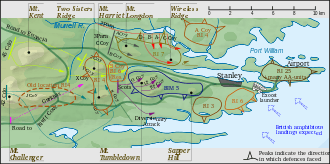
This uncoordinated advance caused great difficulties in planning for the commanders of the combined operation, as they now found themselves with 30 miles (48 km) of indefensible positions, strung along their southern flank. Support could not be sent by air as the single remaining Chinook was already heavily oversubscribed. The soldiers could march, but their equipment and heavy supplies would need to be ferried by sea.
Plans were drawn up for half the Welsh Guards to march light on the night of 2 June, whilst the Scots Guards and the second half of the Welsh Guards were to be ferried from San Carlos Water in the Landing Ship Logistics (LSL) Sir Tristram and the landing platform dock (LPD) Intrepid on the night of 5 June. Intrepid was planned to stay one day and unload itself and as much of Sir Tristram as possible, leaving the next evening for the relative safety of San Carlos. Escorts would be provided for this day, after which Sir Tristram would be left to unload using a Mexeflote (a powered raft) for as long as it took to finish.
Political pressure from above to not risk the LPD forced Commodore Michael Clapp to alter this plan. Two lower-value LSLs would be sent, but with no suitable beaches to land on, Intrepid's landing craft would need to accompany them to unload. A complicated operation across several nights with Intrepid and her sister ship Fearless sailing half-way to dispatch their craft was devised.
The attempted overland march by half the Welsh Guards failed, possibly as they refused to march light and attempted to carry their equipment. They returned to San Carlos and landed directly at Bluff Cove when Fearless dispatched her landing craft. Sir Tristram sailed on the night of 6 June and was joined by Sir Galahad at dawn on 7 June. Anchored 1,200 feet (370 m) apart in Port Pleasant, the landing ships were near Fitzroy, the designated landing point.
The landing craft should have been able to unload the ships to that point relatively quickly, but confusion over the ordered disembarkation point (the first half of the Guards going direct to Bluff Cove) resulted in the senior Welsh Guards infantry officer aboard insisting that his troops should be ferried the far longer distance directly to Port Fitzroy/Bluff Cove. The alternative was for the infantrymen to march via the recently repaired Bluff Cove bridge (destroyed by retreating Argentine combat engineers) to their destination, a journey of around seven miles (11 km).
On Sir Galahad's stern ramp there was an argument about what to do. The officers on board were told that they could not sail to Bluff Cove that day. They were told that they had to get their men off ship and onto the beach as soon as possible as the ships were vulnerable to enemy aircraft. It would take 20 minutes to transport the men to shore using the LCU and Mexeflote. They would then have the choice of walking the seven miles to Bluff Cove or wait until dark to sail there. The officers on board said that they would remain on board until dark and then sail. They refused to take their men off the ship. They possibly doubted that the bridge had been repaired due to the presence on board Sir Galahad of the Royal Engineer Troop whose job it was to repair the bridge. The Welsh Guards were keen to rejoin the rest of their Battalion, who were potentially facing the enemy without their support. They had also not seen any enemy aircraft since landing at San Carlos and may have been overconfident in the air defences. Ewen Southby-Tailyour gave a direct order for the men to leave the ship and go to the beach; the order was ignored.[118]
The longer journey time of the landing craft taking the troops directly to Bluff Cove and the squabbling over how the landing was to be performed caused an enormous delay in unloading. This had disastrous consequences. Without escorts, having not yet established their air defence, and still almost fully laden, the two LSLs in Port Pleasant were sitting targets for two waves of Argentine A-4 Skyhawks.
The disaster at Port Pleasant (although often known as Bluff Cove) would provide the world with some of the most sobering images of the war as TV news video footage showed Navy helicopters hovering in thick smoke to winch survivors from the burning landing ships.
British casualties were 48 killed and 115 wounded.[119] Three Argentine pilots were also killed. The air strike delayed the scheduled British ground attack on Stanley by two days.[120] Argentine General Mario Menéndez, commander of Argentine forces in the Falklands, was told that 900 British soldiers had died. He expected that the losses would cause enemy morale to drop and the British assault to stall.
Fall of Stanley
On the night of 11 June, after several days of painstaking reconnaissance and logistic build-up, British forces launched a brigade-sized night attack against the heavily defended ring of high ground surrounding Stanley. Units of 3 Commando Brigade, supported by naval gunfire from several Royal Navy ships, simultaneously attacked in the Battle of Mount Harriet, Battle of Two Sisters, and Battle of Mount Longdon. Mount Harriet was taken at a cost of 2 British and 18 Argentine soldiers. At Two Sisters, the British faced both enemy resistance and friendly fire, but managed to capture their objectives. The toughest battle was at Mount Longdon. British forces were bogged down by rifle, mortar, machine gun, artillery fire, sniper fire, and ambushes. Despite this, the British continued their advance.
During this battle, 13 were killed when HMS Glamorgan, straying too close to shore while returning from the gun line, was struck by an improvised trailer-based Exocet MM38 launcher taken from the destroyer ARA Seguí by Argentine Navy technicians.[121] On the same day, Sergeant Ian McKay of 4 Platoon, B Company, 3 Para died in a grenade attack on an Argentine bunker, which earned him a posthumous Victoria Cross. After a night of fierce fighting, all objectives were secured. Both sides suffered heavy losses.
The second phase of attacks began on the night of 13 June, and the momentum of the initial assault was maintained. 2 Para, with light armour support from the Blues and Royals, captured Wireless Ridge, with the loss of 3 British and 25 Argentine lives, and the 2nd battalion, Scots Guards captured Mount Tumbledown at the Battle of Mount Tumbledown, which cost 10 British and 30 Argentine lives.
With the last natural defence line at Mount Tumbledown breached, the Argentine town defences of Stanley began to falter. In the morning gloom, one company commander got lost and his junior officers became despondent. Private Santiago Carrizo of the 3rd Regiment described how a platoon commander ordered them to take up positions in the houses and "if a Kelper resists, shoot him", but the entire company did nothing of the kind.[122]
A ceasefire was declared on 14 June and the commander of the Argentine garrison in Stanley, Brigade General Mario Menéndez, surrendered to Major General Jeremy Moore the same day.
Recapture of South Sandwich Islands
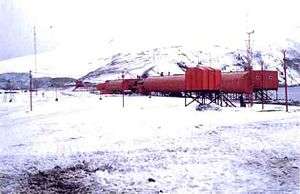
On 20 June, the British retook the South Sandwich Islands, which involved accepting the surrender of the Southern Thule Garrison at the Corbeta Uruguay base, and declared hostilities over. Argentina had established Corbeta Uruguay in 1976, but prior to 1982 the United Kingdom had contested the existence of the Argentine base only through diplomatic channels.[123]
Casualties
In total, 907 were killed during the 74 days of the conflict:
- Argentina – 649[124]
- Ejército Argentino (Army) – 194 (16 officers, 35 non-commissioned officers (NCO) and 143 conscript privates)[125]
- Armada de la República Argentina (Navy) – 341 (including 321 in ARA General Belgrano and 4 naval aviators)
- IMARA (Marines) – 34[126]
- Fuerza Aérea Argentina (Air Force) – 55 (including 31 pilots and 14 ground crew)[127]
- Gendarmería Nacional Argentina (Border Guard) – 7
- Prefectura Naval Argentina (Coast Guard) – 2
- Civilians – 16
- United Kingdom – A total of 255 British servicemen and 3 female Falkland Island civilians were killed during the Falklands War.[128]
- Royal Navy – 86 + 2 Hong Kong laundrymen (see below)[129]
- Royal Marines – 27 (2 officers, 14 NCOs and 11 marines)[130]
- Royal Fleet Auxiliary – 4 + 6 Hong Kong sailors[131][132]
- Merchant Navy – 6[131]
- British Army – 123 (7 officers, 40 NCOs and 76 privates)[133][134][135]
- Royal Air Force – 1 (1 officer)[131]
- Falkland Islands civilians – 3 women killed by friendly fire[131]
Of the 86 Royal Navy personnel, 22 were lost in HMS Ardent, 19 + 1 lost in HMS Sheffield, 19 + 1 lost in HMS Coventry and 13 lost in HMS Glamorgan. Fourteen naval cooks were among the dead, the largest number from any one branch in the Royal Navy.
Thirty-three of the British Army's dead came from the Welsh Guards (32 of which died on the RFA Sir Galahad in the Bluff Cove Air Attacks), 21 from the 3rd Battalion, the Parachute Regiment, 18 from the 2nd Battalion, the Parachute Regiment, 19 from the Special Air Service, 3 from Royal Signals and 8 from each of the Scots Guards and Royal Engineers. The 1st battalion/7th Duke of Edinburgh's Own Gurkha Rifles lost one man.
There were 1,188 Argentine and 777 British non-fatal casualties.
Red Cross Box
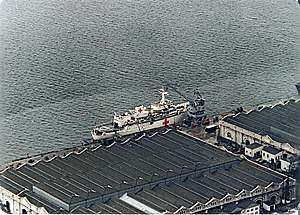
Before British offensive operations began, the British and Argentine governments agreed to establish an area on the high seas where both sides could station hospital ships without fear of attack by the other side. This area, a circle 20 nautical miles in diameter, was referred to as the Red Cross Box (48°30′S 53°45′W), about 45 miles (72 km) north of Falkland Sound.[136] Ultimately, the British stationed four ships (HMS Hydra, HMS Hecla and HMS Herald and the primary hospital ship SS Uganda) within the box, while the Argentines stationed three (ARA Almirante Irízar, ARA Bahía Paraíso and Puerto Deseado).
The hospital ships were non-warships converted to serve as hospital ships. The three British naval vessels were survey vessels and Uganda was a passenger liner. Almirante Irizar was an icebreaker, Bahia Paraiso was an Antarctic supply transport and Puerto Deseado was a survey ship. The British and Argentine vessels operating within the Box were in radio contact and there was some transfer of patients between the hospital ships. For example, the Uganda on four occasions transferred patients to an Argentine hospital ship. The British naval hospital ships operated as casualty ferries, carrying casualties from both sides from the Falklands to Uganda and operating a shuttle service between the Red Cross Box and Montevideo, Uruguay.
Throughout the conflict officials of the International Committee of the Red Cross (ICRC) conducted inspections to verify that all concerned were abiding by the rules of the Geneva Conventions. On 12 June, some personnel were transferred from the Argentine hospital ship to the British ships by helicopter. Argentine naval officers also inspected the British casualty ferries in the estuary of the River Plate.
British casualty evacuation
Hydra worked with Hecla and Herald to take casualties from Uganda to Montevideo, Uruguay, where a fleet of Uruguayan ambulances met them. RAF VC10 aircraft then flew the casualties to the UK for transfer to the Princess Alexandra Hospital at RAF Wroughton, near Swindon.[137]
Aftermath
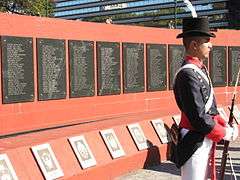
This brief war brought many consequences for all the parties involved, besides the considerable casualty rate and large materiel loss, especially of shipping and aircraft, relative to the deployed military strengths of the opposing sides.
In the United Kingdom, Margaret Thatcher's popularity increased. The success of the Falklands campaign was widely regarded as a factor in the turnaround in fortunes for the Conservative government, who had been trailing behind the SDP-Liberal Alliance in the opinion polls for months before the conflict began, but after the success in the Falklands the Conservatives returned to the top of the opinion polls by a wide margin and went on to win the following year's general election by a landslide.[138] Subsequently, Defence Secretary Nott's proposed cuts to the Royal Navy were abandoned.
The islanders subsequently had full British citizenship restored in 1983, their lifestyle was improved by investments the UK made after the war and by the liberalisation of economic measures that had been stalled through fear of angering Argentina. In 1985, a new constitution was enacted promoting self-government, which has continued to devolve power to the islanders.
In Argentina, defeat in the Falklands War meant that a possible war with Chile was avoided. Further, Argentina returned to a democratic government in the 1983 general election, the first free general election since 1973. It also had a major social impact, destroying the military's image as the "moral reserve of the nation" that they had maintained through most of the 20th century.
Various figures have been produced for the number of veterans who have committed suicide since the war. Some studies have estimated that 264 British veterans and 350–500 Argentine veterans have committed suicide since 1982.[139][140] However, a detailed study[141] of 21,432 British veterans of the war commissioned by the UK Ministry of Defence found that only 95 had died from "intentional self-harm and events of undetermined intent (suicides and open verdict deaths)", a proportion lower than would be expected within the general population over the same period.[142]
Military analysis
Militarily, the Falklands conflict remains one of the largest air-naval combat operations between modern forces since the end of the Second World War. As such, it has been the subject of intense study by military analysts and historians. The most significant "lessons learned" include: the vulnerability of surface ships to anti-ship missiles and submarines, the challenges of co-ordinating logistical support for a long-distance projection of power, and reconfirmation of the role of tactical air power, including the use of helicopters.
In 1986, the BBC broadcast the Horizon programme, In the Wake of HMS Sheffield, which discussed lessons learned from the conflict, and measures since taken to implement them, such as stealth ships and close-in weapon systems.
Memorials
.jpg)
There are several memorials on the Falkland Islands themselves, the most notable of which is the 1982 Liberation Memorial, unveiled in 1984 on the second anniversary of the end of the war. It lists the names of the 255 British military personnel who died during the war and is located in front of the Secretariat Building in Stanley, overlooking Stanley Harbour. The Memorial was funded entirely by the Islanders and is inscribed with the words "In Memory of Those Who Liberated Us".[143]
In addition to memorials on the islands, there is a memorial in the crypt of St Paul's Cathedral, London to the British war dead.[144] The Falkland Islands Memorial Chapel at Pangbourne College was opened in March 2000 as a commemoration of the lives and sacrifice of all those who served and died in the South Atlantic in 1982.[145] In Argentina, there is a memorial at Plaza San Martín in Buenos Aires,[146] another one in Rosario, and a third one in Ushuaia.
During the war, British dead were put into plastic body bags and buried in mass graves. After the war, the bodies were recovered; 14 were reburied at Blue Beach Military Cemetery and 64 were returned to the UK.
Many of the Argentine dead are buried in the Argentine Military Cemetery west of the Darwin Settlement. The government of Argentina declined an offer by the UK to have the bodies repatriated to the mainland.[147]
Minefields
As of 2011, there were 113 uncleared minefields on the Falkland Islands and unexploded ordnance (UXOs) covering an area of 13 km2 (5.0 sq mi). Of this area, 5.5 km2 (2.1 sq mi) on the Murrell Peninsula were classified as being "suspected minefields"—the area had been heavily pastured for the previous 25 years without incident. It was estimated that these minefields had 20,000 anti-personnel mines and 5,000 anti-tank mines. No human casualties from mines or UXO have been reported in the Falkland Islands since 1984, and no civilian mine casualties have ever occurred on the islands.
The UK reported six military personnel were injured in 1982 and a further two injured in 1983. Most military accidents took place while clearing the minefields in the immediate aftermath of the 1982 conflict or in the process of trying to establish the extent of the minefield perimeters, particularly where no detailed records existed.
On 9 May 2008, the Falkland Islands Government asserted that the minefields, which represent 0.1% of the available farmland on the islands "present no long term social or economic difficulties for the Falklands," and that the impact of clearing the mines would cause more problems than containing them. However, the British Government, in accordance with its commitments under the Mine Ban Treaty has a commitment to clear the mines by the end of 2019.[148][149]
In May 2012, it was announced that 3.7 km2 (1.4 sq mi) of Stanley Common (which lies between the Stanley – Mount Pleasant road and the shoreline) was made safe and had been opened to the public, opening up a 3 km (1.9 mi) stretch of coastline and a further two kilometres of shoreline along Mullet's Creek.[150] The 2019 deadline has not been achieved but clearance is currently scheduled for completion by 2024.[151]
Press and publicity
Argentina
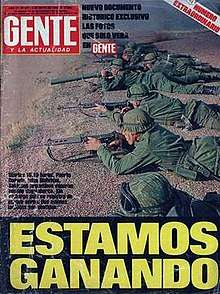
Selected war correspondents were regularly flown to Port Stanley in military aircraft to report on the war. Back in Buenos Aires, newspapers and magazines faithfully reported on "the heroic actions of the largely conscript army and its successes".[19]
Officers from the intelligence services were attached to the newspapers and 'leaked' information confirming the official communiqués from the government. The glossy magazines Gente and Siete Días swelled to 60 pages with colour photographs of British warships in flames—many of them faked—and bogus eyewitness reports of the Argentine commandos' guerrilla war on South Georgia (6 May) and an already dead Pucará pilot's attack on HMS Hermes[19] (Lt. Daniel Antonio Jukic had been killed at Goose Green during a British air strike on 1 May). Most of the faked photos actually came from the tabloid press. One of the best remembered headlines was "Estamos ganando" ("We're winning") from the magazine Gente, that would later use variations of it.[152]
The Argentine troops on the Falkland Islands could read Gaceta Argentina—a newspaper intended to boost morale among the servicemen. Some of its untruths could easily be unveiled by the soldiers who recovered corpses.[153]
The Malvinas cause united the Argentines in a patriotic atmosphere that protected the junta from critics, and even opponents of the military government supported Galtieri; Ernesto Sabato said: "Don't be mistaken, Europe; it is not a dictatorship who is fighting for the Malvinas, it is the whole Nation. Opponents of the military dictatorship, like me, are fighting to extirpate the last trace of colonialism." The Madres de Plaza de Mayo were even exposed to death threats from ordinary people.[19]
HMS Invincible was repeatedly sunk in the Argentine press,[154] and on 30 April 1982 the Argentine magazine Tal Cual showed Prime Minister Thatcher with an eyepatch and the text: Pirate, witch and assassin. Guilty![155] Three British reporters sent to Argentina to cover the war from the Argentine perspective were jailed until the end of the war.[156]
United Kingdom
.png)
Seventeen newspaper reporters, two photographers, two radio reporters and three television reporters with five technicians sailed with the Task Force to the war. The Newspaper Publishers' Association selected them from among 160 applicants, excluding foreign media. The hasty selection resulted in the inclusion of two journalists among the war reporters who were interested only in Queen Elizabeth II's son Prince Andrew, who was serving in the conflict.[157] The Prince flew a helicopter on multiple missions, including Anti-Surface Warfare, Exocet missile decoy and casualty evacuation.
Merchant vessels had the civilian Inmarsat uplink, which enabled written telex and voice report transmissions via satellite. SS Canberra had a facsimile machine that was used to upload 202 pictures from the South Atlantic over the course of the war. The Royal Navy leased bandwidth on the U.S. Defense Satellite Communications System for worldwide communications. Television demands a thousand times the data rate of telephone, but the Ministry of Defence was unsuccessful in convincing the U.S. to allocate more bandwidth.[158]
TV producers suspected that the enquiry was half-hearted; since the Vietnam War television pictures of casualties and traumatised soldiers were recognised as having negative propaganda value. However, the technology only allowed uploading a single frame per 20 minutes—and only if the military satellites were allocated 100% to television transmissions. Videotapes were shipped to Ascension Island, where a broadband satellite uplink was available, resulting in TV coverage being delayed by three weeks.[158]
The press was very dependent on the Royal Navy, and was censored on site. Many reporters in the UK knew more about the war than those with the Task Force.[158] Ministry of Defence press briefings in London were characterised by the restrained dictation-speed delivery of its spokesman, Ian McDonald.[159]
The Royal Navy expected Fleet Street to conduct a Second World War-style positive news campaign[160] but the majority of the British media, especially the BBC, reported the war in a neutral fashion.[161] These reporters referred to "the British troops" and "the Argentinian troops" instead of "our lads" and the "Argies".[162] The two main tabloid papers presented opposing viewpoints: The Daily Mirror was decidedly anti-war, whilst The Sun became well known for headlines such as "Stick It Up Your Junta!," which, along with the reporting in other tabloids,[163] led to accusations of xenophobia[154][163][164] and jingoism.[154] [164][165][166] The Sun was condemned for its "Gotcha" headline following the sinking of the ARA General Belgrano.[167][168][169]
Cultural impact
There were wide-ranging influences on popular culture in both the UK and Argentina, from the immediate postwar period to the present. The Argentine writer Jorge Luis Borges described the war as "a fight between two bald men over a comb".[170] The words yomp and Exocet entered the British vernacular as a result of the war. The Falklands War also provided material for theatre, film and TV drama and influenced the output of musicians. In Argentina, the military government banned the broadcasting of music in the English language, giving way to the rise of local rock musicians.[171]
See also
- Beagle conflict, a border dispute between Chile and Argentina that involved island territory.
- Hope Bay incident, Argentine aggression on the Antarctic Peninsula
- Operation Algeciras, a failed Argentine plan to send Montoneros to sabotage British military facilities in Gibraltar
- Operation Soberanía, plans for Argentina's invasion of Chile in 1978 and later.
- Reassertion of British sovereignty over the Falkland Islands (1833)
- Argentina–United Kingdom relations
Notes
- 6 Pucaras, 4 T-34 Mentor and 1 Short Skyvan
- 21/27 May: 9 Dagger, 5 A-4C, 3 A-4Q, 3 A-4B & 2 Pucara
- Location: "Bomb Alley" San Carlos Water, Falkland Islands
- Location: Mount Kent, Falkland Islands
- Buenos Aires War Memorial is at coordinates 34.59373°S 58.374782°W
Footnotes
- "Falkland Islands profile". BBC News. 5 November 2013. Retrieved 19 June 2014.
- Burns, John F. (5 January 2013). "Vitriol Over Falklands Resurfaces, as Do Old Arguments". The New York Times. Retrieved 8 August 2019.
- Historia Marítima Argentina, Volume 10, p. 137. Departamento de Estudios Históricos Navales, Cuántica Editora, Argentina: 1993.
- "Argentine to reaffirm Sovereignty Rights over The Falkland Islands". National Turk. 4 January 2012. Retrieved 7 January 2012.
- "Cómo evitar que Londres convierta a las Malvinas en un Estado independiente". Clarin. Retrieved 7 February 2010.
- "Joint statement of 19 October 1989: Re-establishing Consular Relations Between Britain and Argentina, and Agreeing a Framework on Sovereignty Which Would Allow Further Talks". Falklands info. Archived from the original on 17 May 2012. Retrieved 4 January 2013.
- "Constitución Nacional". Argentine Senate (in Spanish). Archived from the original on 17 June 2004.
La Nación Argentina ratifica su legítima e imprescriptible soberanía sobre las Islas Malvinas, Georgias del Sur y Sandwich del Sur y los espacios marítimos e insulares correspondientes, por ser parte integrante del territorio nacional.
- "Argentina: Constitución de 1994". pdba.georgetown.edu. Retrieved 3 August 2020.
- Welch, David A. (2011). Painful Choices: A Theory of Foreign Policy Change. Google Books: Princeton University Press. p. 75. ISBN 9781400840748. Retrieved 25 January 2020.
- Paul Eddy; Magnus Linklater; Peter Gillman; Sunday Times of London Insight Team (1982). The Falklands War. Google Books: André Deutsch. p. 53. Retrieved 25 January 2020.
- White, Rowland (2006). Vulcan 607. London: Bantam Press. pp. 13–14. ISBN 9780593053928.
The price for Anaya's blessing was approval for the navy's plan to seize Las Malvinas, the Falkland Islands
- Bicheno 2006, p. 25: "A basic assumption underlying the conflict was that the British were, in the opinion of the war's main architect, Admiral Jorge Anaya, unworthy heirs to a glorious heritage, the men mainly maricones… to call a man a maricón does not question his heterosexuality; but it definitely impugns his physical and moral courage. Anaya was Naval Attaché in London from January 1975 to January 1976 … He returned to Argentina, making no attempt to conceal his contempt for all things British."
- Middlebrook 1989, p. 1: "He was an ardent 'Malvinist' … Anaya was enthusiastic, and his orders in the last days of 1981 were to set in train that tragic series of events."
- Boughton, James M. (2001). "Silent Revolution: The IMF 1979–1989" (PDF). IMF. pp. 328–329. Retrieved 28 June 2019.
- "Argentina – the horrors of a dictatorial past live on – Radio Netherlands Worldwide – English". Radionetherlands.nl. 30 March 2006. Archived from the original on 16 March 2009. Retrieved 7 February 2010.
- Kirschbaum, Oscar; Van Der Kooy, Roger; Cardoso, Eduardo (1983). Malvinas, La Trama Secreta (in Spanish). Buenos Aires: Sudamericana/Planeta. ISBN 978-950-37-0006-8.
- "Haig: "Malvinas fue mi Waterloo"". La Nación (in Spanish). 10 August 1997. Retrieved 25 October 2010.
¿Qué creía? Que tenía que ver con despertar el orgullo nacional y con otra cosa. ... La junta – Galtieri me lo dijo – nunca creyó que los británicos darían pelea. Él creía que Occidente se había corrompido. Que los británicos no tenían Dios, que Estados Unidos se había corrompido… Nunca lo pude convencer de que ellos no sólo iban a pelear, que además iban a ganar." ("What do you believe? This was neither about national pride nor anything else. … The junta – Galtieri told me – never believed the British would respond. He thought the Western World was corrupt. That the British people had no God, that the U.S. was corrupt… I could never convince him that the British would not only fight back but also win [the war].
- "Ministerio de Educación, Ciencia y Tecnología de la Nación" (PDF). Archived from the original (PDF) on 18 March 2009. Retrieved 7 February 2010.
- Jimmy Burns: The land that lost its heroes, 1987, Bloomsbury Publishing, ISBN 0-7475-0002-9.
- Briley, Harold (9 April 1997). "Obituary: Captain Nicholas Barker". The Independent. UK. p. 16. Retrieved 2 March 2011.
- Barnett, Correlli (1997). "The high cost of cuts". The Spectator. Retrieved 7 February 2010.
- "The Falklands War 1982 – Operation Rosario". The British Empire. Retrieved 21 September 2018.
- "Falklands War: The first day, 2 April 1982". 2 April 2002. Retrieved 21 September 2018.
- Freedman, Lawrence; Gamba-Stonehouse, Virginia (1991). Signals of War: The Falklands Conflict of 1982. Princeton University Press. ISBN 978-1-4008-6158-3.
- Freedman 2005a, pp. 202–203
- "A Chronology of events during the Falklands Conflict of 1982". Falkland Islands Information. Archived from the original on 27 March 2010. Retrieved 24 December 2011.
- Margolis, Laurie (2 April 2007). "UK | How BBC man scooped invasion news". BBC News. Retrieved 7 February 2010.
- Duncan, Andrew, The Falklands War, Marshall Cavendish Books Limited, ISBN 1-84415-429-7
- "No. 49194". The London Gazette (Supplement). 13 December 1982. p. 16109.
- Freedman 2005b, pp. 21–22: "day-to-day oversight was to be provided by ... which came to be known as the War Cabinet. This became the critical instrument of crisis management"
- Parsons, Anthony (1983). "The Falklands Crisis in the United Nations, 31 March-14 June 1982". International Affairs (Royal Institute of International Affairs 1944-). Oxford University Press on behalf of the Royal Institute of International Affairs. 59 (2): 169–178.
- Gold, Peter (2005). Gibraltar, British or Spanish?. Routledge. p. 39. ISBN 978-0-415-34795-2.
- Gold, Peter (2005). Gibraltar, British or Spanish?. Routledge. p. 37. ISBN 978-0-415-34795-2.
- "Voting System". UNITED NATIONS SECURITY COUNCIL. United Nations. Retrieved 20 June 2020.
- "CHAPTER VII: ACTION WITH RESPECT TO THREATS TO THE PEACE, BREACHES OF THE PEACE, AND ACTS OF AGGRESSION". CHARTER OF THE UNITED NATIONS. United Nations. Retrieved 19 June 2020.
- Martin, Lisa L. (Spring 1992). "Institutions and Cooperation: Sanctions during the Falkland Islands Conflict" (PDF). International Security. p9. 16 (4): 143–178. doi:10.2307/2539190. JSTOR 2539190. Retrieved 11 December 2018.CS1 maint: location (link)
- Krepp, Stella Paresa; Krepp, Stella Paresa (April 2017). "Between the Cold War and the Global South: Argentina and Third World Solidarity in the Falklands/Malvinas Crisis". Estudos Históricos (Rio de Janeiro). 30 (60): 141–160. doi:10.1590/s2178-14942017000100008. ISSN 0103-2186.
- "Falklands War cartoon". NZ History. Ministry for Culture and Heritage. 20 November 2013. Retrieved 17 September 2018.
- Black, Joanne (9 April 2013). "From our archive: when Rob met Maggie". New Zealand Listener. Retrieved 17 September 2018.
- New Zealand Foreign Affairs Review, Volume 32 p. 44, Ministry of Foreign Affairs, 1982
- United Kingdom, Parliamentary Debate, Debates, 20 May 1982. https://api.parliament.uk/historic-hansard/commons/1982/may/20/engagements
- Thomson, Mike (5 March 2012). "How France helped both sides in the Falklands War". BBC.
- Fremont-Barnes, Gregory. "An A-Z of the Falklands War". The History Press. Retrieved 16 October 2018.
- John, Nott (2002). "Here Today, Gone Tomorrow". Archived from the original on 22 November 2010.
As soon as the conflict began Hernou (French Defence Minister) got in touch with me to make available a Super-Étendard and Mirage aircraft so our Harrier pilots could train against them before setting off to the South Atlantic. (John Nott, defence minister during the Falklands war)
- John, Nott (2002). "Here Today, Gone Tomorrow". Archived from the original on 22 November 2010.
A remarkable world-wide operation then ensured to prevent further Exocets being bought by Argentina. I authorised our agents to pose as bona fide purchasers of equipment on the international market, ensuring that we outbid the Argentines. Other agents identified Exocet missiles in various markets and covertly rendered them inoperable, based on information from the French. (John Nott, defence minister during the Falklands war)
- "Thomson, Mike"
- "Falklands: MT message to President Stevens of Sierra Leone (thanks for allowing Navy ships to refuel at Freetown)". Margaret Thatcher Foundation. 24 April 1982. Retrieved 8 October 2018.
- Borger, Julian (1 April 2012). "U.S. feared Falklands war would be 'close-run thing', documents reveal". The Guardian. London.
- Grimmett, Richard F. (1 June 1999). "Foreign Policy Roles of the President and Congress". U.S. Department of State. Retrieved 24 February 2010.
- Paul Reynolds, "Obituary: Caspar Weinberger," BBC News, 28 March 2006.
- Prime Minister Margaret Thatcher was to later write: "Without the Harriers … using the latest version of the Sidewinder air-to-air missile supplied by Caspar Weinberger, we could not have retaken the Falklands." Dan Snow, Peter Snow, p. 270, 20th Century Battlefields, Random House, 2012
- "Reagan Readied U.S. Warship for '82 Falklands War". News and Analysis, U.S. Naval Institute. 27 June 2012. Retrieved 27 June 2012.
- "The Peruvian Exocet connection in the Falklands/Malvinas war". Mercopress. 3 April 2012. Retrieved 21 April 2012.
- "El otro rol de Peru durante la guerra de Malvinas". Infobae (in Spanish). 1 April 2012. Archived from the original on 5 May 2012. Retrieved 21 April 2012.
- Interview with Chilean Air Force Chief during the Falklands War Fernando Matthei Malvinas: "Hice todo lo posible para que Argentina perdiera la guerra" in Clarin, Buenos Aires on 1. September 2005. Retrieved 11 Jule 2011
- Freedman 2005b, pp. 397
- "The best trained units of the Argentine army, the 6th and 8th Mountain Brigades and the 11th Cold Weather Brigade were left behind to guard the frontier with Chile." Pradeep Barua, p. 152, The Military Effectiveness of Post-Colonial States, BRILL, 2013
- "Royal Fleet Auxiliary Tidepool". RFA Historical Society. Retrieved 4 July 2019.
- Oyarzún Lemonnier, Agustín (1983). Guerra en las Falklands (in Spanish). Editorial Cumbres. p. 199.
- Lepot, François (2002). Malvinas desde Londres (in Spanish). Ciudad Argentina. p. 254.
- Robin Yapp (20 April 2011). "Israel 'supplied arms to Argentina during Falklands War'". The Daily Telegraph. London. Retrieved 18 April 2012.
- "Begin aided Argentina during Falklands War to avenge the British". Haaretz. 21 April 2011. Retrieved 18 April 2012.
- "Tras el pedido de perdón y en medio de elogios, Cristina regresó de Perú" in Argentine newspaper Clarín on 24 March 2010 (in Spanish)
- Land that Lost Its Heroes: How Argentina Lost the Falklands War, Jimmy Burns, p. 190, Bloomsbury Publishing, 11 April 2012
- van der Bijl, Nick (1999). Nine battles to Stanley. Leo Cooper. p. 141. ISBN 978-0850526196.
The Junta were slow to admit defeat, but when the news was broadcast, Venezuela and Guatemala offered to send airborne units to 'smash the British in the Falklands'.
- Hernan Dobry in article Kadafi fue un amigo solidario de la dictadura durante Malvinas Archived 17 September 2011 at the Wayback Machine, in Argentine newspaper Perfil on 27 February 2011, in Spanish language
- "Brazil helped Soviet support operation for Argentina during the Falklands conflict". MercoPress. 23 April 2012. Retrieved 6 June 2012.
- "The Falkland Islands Conflict, 1982". Global Security. Retrieved 25 December 2011.
- Woodward & Robinson 1997, p. 72 Cited in To Rule The Waves: How the British Navy Shaped the Modern World Herman, A. (2004) Harper Collins, New York, p. 560.
- Freedman 2005b, pp. 431–444 "During the course of May confidence that the naval threat was under control grew. Optimism on the air threat was much scarcer, especially among those who might be on the receiving end."
- "AV-8B Harrier Operations". GlobalSecurity.org. Retrieved 21 April 2010.
- "Argentine Airpower in the Falklands War". Airpower.maxwell.af.mil. Archived from the original on 2 January 2014. Retrieved 4 January 2013.
- Hastings, Max; Jenkins, Simon (1983). The Battle for the Falklands. Norton. pp. 115–116. ISBN 978-0-393-30198-4.
- "FAA map". Archived from the original on 24 October 2007. Retrieved 24 October 2007.
- Brown 1987, p. 110
- "Submarine Operations during the Falklands War – U.S. Naval War College". Retrieved 7 February 2010.
- "1982: Marines land in South Georgia". BBC. 25 April 1982. Retrieved 20 June 2005.
- Ward 2000, p. 186: "... to get twenty-one bombs to Port Stanley is going to take about one million, one hundred thousand pounds of fuel – equalled about 137,000 gallons. That was enough fuel to fly 260 Sea Harrier bombing missions over Port Stanley. Which in turn meant just over 1300 bombs. Interesting stuff!"
- Freedman 2005b, pp. 285
- Freedman 2005b, pp. 285–286
- "Offensive Air Operations of the Falklands War". Globalsecurity.org.
As a result of these heavy losses ... it was decided to pull the Mirage III's back to the mainland to stand alert for a possible Vulcan attack.
- "The Falkland Islands Conflict, 1982: Air Defense of the Fleet". Globalsecurity.org.
Finally, the bombing raids caused the Argentines to fear an air attack on the mainland, causing them to retain some Mirage aircraft and Roland missiles for defense.
- "La familia Mirage". Aeroespacio (in Spanish). ISSN 0001-9127. Archived from the original on 31 May 2011.
"Los M III debían defender el territorio continental argentino de posibles ataques de los bombarderos Vulcan de la RAF, brindar escolta a los cazabombarderos de la FAA, e impedir los ataques de aviones de la Royal Navy y de la RAF sobre las Malvinas."
("The M III would defend the Argentine mainland against possible attacks by Vulcan bombers from the RAF, providing escort of fighter bombers to the FAA, and to prevent attacks by aircraft of the Royal Navy and RAF on the Falklands.") - "The Falkland Islands Conflict, 1982: Air Defense of the Fleet". Globalsecurity.org.
Unfortunately the British Secretary of State for Defence announced sometime later that Britain would not bomb targets on the Argentine mainland. This statement was undoubtedly welcomed by the Argentine military command, because it permitted the very limited number of Roland SAM's to be deployed around the airfield at Stanley.
- Ward 2000, pp. 247–48: "Propaganda was, of course, used later to try to justify these missions: 'The Mirage IIIs were withdrawn from Southern Argentina to Buenos Aires to add to the defences there following the Vulcan raids on the islands.' Apparently the logic behind this statement was that if the Vulcan could hit Port Stanley, the [sic] Buenos Aires was well within range as well and was vulnerable to similar attacks. I never went along with that baloney. A lone Vulcan or two running in to attack Buenos Aires without fighter support would have been shot to hell in quick time."-"Mirage IIIs were in evidence near the islands on several occasions during the conflict, either escorting the Neptune reconnaissance missions or on 'interference' flights that attempted to draw CAP attention away from air-to-ground attacks."-"Suffice it to say that you didn't need more than one or two Mirage IIIs to intercept a Vulcan attack on Buenos Aires"-"It would have taken much more than a lone Vulcan raid to upset Buenos Aires"
- "Argentine Air Force remembers its 'baptism of fire' twenty years on". En.mercopress.com. 1 May 2002. Retrieved 9 June 2010.
- Rodríguez Mottino, Horacio (1984). La artillería argentina en Malvinas (in Spanish). Editorial Clio. p. 170. ISBN 978-9509377028.
- "Rodolfo Manuel de la Colina". Fuerza Aérea Argentina (in Spanish). Archived from the original on 7 October 2014. Retrieved 12 March 2015.
- "Noticias Municipales | Puerto Madryn". Madryn.gov.ar. 2 April 2009. Archived from the original on 15 April 2012. Retrieved 4 January 2013.
- "Fuerza Aérea Argentina". Fuerzaaerea.mil.ar. Archived from the original on 30 April 2009. Retrieved 7 February 2010.
- "ASN Aircraft accident description Lockheed C-130H Hercules TC-63 – Pebble Island". Aviation-safety.net. Retrieved 7 February 2010.
- Evans, Michael (27 November 2007). "Underwater and undercover: how nuclear subs were first line of Falklands defence". The Times. London.
- Peter Beaumont (25 May 2003). "Belgrano crew 'trigger happy'". The Guardian. Retrieved 20 May 2018.
- Woodward & Robinson 1997, p. 8
- Charles Moore, Margaret Thatcher: The Authorized Biography (2013) Volume 1, pp. 726–728
- "The SAS vs the Exocet". eliteukforces.info. 27 October 2007. Retrieved 7 February 2010.
- Evans, Michael; Hamilton, Alan (27 June 2005). "Thatcher in the dark on sinking of Belgrano". The Times.
- "British Special Air Service SAS – The Falklands – Operation Corporate". Retrieved 2 October 2014.
- Rumley, Leesa (1 June 2007). "Captain Hart Dyke, Commanding Officer of HMS Coventry". BBC News. Retrieved 7 February 2010.
- Corum, James S. (2002). "Argentine Airpower in the Falklands War: An Operational View". Air and Space Power Journal. 16 (3): 59–77. Archived from the original on 2 January 2014.
- A simple free-fall bomb in a low-altitude release impacts almost directly below the aircraft, which is then within the lethal fragmentation zone of the explosion. A retarded bomb has a small parachute or air brake that opens to reduce the speed of the bomb to produce a safe horizontal separation between the bomb and the aircraft. The fuze for a retarded bomb requires that the retarder be open a minimum time to ensure safe separation.
- Woodward & Robinson 1997
- "British Ships Sunk and Damaged – Falklands War 1982". Naval-history.net. Retrieved 7 February 2010.
- Gethin Chamberlain (5 April 2002). "Would British forces be able to retake the Falklands today?". The Scotsman. UK. p. 12. Archived from the original on 27 March 2007. Alt URL
- "The Falklands Conflict 1982". Royal Navy. 2 April 1982. Archived from the original on 9 April 2008. Retrieved 7 February 2010.
- "Argentine Aircraft in the Falklands". Britains-smallwars.com. Archived from the original on 23 February 2009. Retrieved 7 February 2010.
- "Argentine Air Force – Group 5". Skyhawk.org. Archived from the original on 9 May 2007. Retrieved 7 February 2010.
- "Super Etendard". Operationcorporate.com. 29 May 2007. Retrieved 7 February 2010.
- "HMS Yarmouth, Captains Diary". Archived from the original on 21 March 2009.
- Yates, David (2006). Bomb Alley – Falkland Islands 1982. Pen and Sword. ISBN 978-1-84415-417-3.
- "Americas | Charles ends Falklands tour on sombre note". BBC News. 15 March 1999. Retrieved 7 February 2010.
- "Captain Paul Bootherstone obituary". The Guardian. 9 April 2001.
- "No. 49134". The London Gazette (Supplement). 8 October 1982. p. 12854.
- "The Argentine Commandos on Mount Kent". Britains-smallwars.com. Archived from the original on 28 March 2010. Retrieved 7 February 2010.
- "Argentine Puma Shot Down By American "Stinger" Missile". En.mercopress.com. 12 April 2002. Retrieved 7 February 2010.
- Julian Thompson, No Picnic, p. 93, Cassell & Co, 2001.
- Rick Jolly, The Red & Green Life Machine, p. 124.
- Ewen Southby-Tailyour (31 December 1990). Reasons in Writing: A Commando's View of the Falklands War. Pen and Sword. p. 297. ISBN 978-1-84415-014-4. "It was clear that I was achieving nothing and so, in desperation, I gave a direct order for the infantry to get ashore with or without their kit in order that we could get on with unloading Sir Tristram.
The officers ignored my order. In doing so they explained to me quite clearly that no orders would be accepted from an officer of equivalent rank." - "1982:Fifty die in Argentine air attack". BBC News. 8 June 1982.
- Bolia, Robert S. "The Falklands War:The Bluff Cove Disaster" (PDF). Military Review (November–December 2004): 71. Archived from the original (PDF) on 16 March 2012.
- "An interview with CL (R) Ing. Julio Pérez, chief designer of Exocet trailer-based launcher" (in Spanish). Archived from the original on 2 March 2008.
- Hastings & Jenkins 1984, p. 307
- "The race to regain Thule". Navy News p.21. July 1982.
- "Ley 24.950: Decláranse "Héroes nacionales" a los combatientes argentinos fallecidos durante la guerra de Malvinas". InfoLEG (in Spanish). 18 March 1998. Retrieved 11 March 2015.
- "list". Ejercito.mil.ar. Archived from the original on 6 April 2010. Retrieved 7 February 2010.
- list Archived 4 February 2010 at the Wayback Machine
- "list". Fuerzaaerea.mil.ar. Archived from the original on 6 April 2010. Retrieved 7 February 2010.
- "Databases – Falklands War 1982". Roll of Honour. Retrieved 4 January 2013.
- "list". Raf.mod.uk. 1 October 2004. Archived from the original on 6 June 2011. Retrieved 7 February 2010.
- "list". Raf.mod.uk. 1 October 2004. Archived from the original on 6 June 2011. Retrieved 7 February 2010.
- "Falkland Islands – A history of the 1982 conflict". Raf.mod.uk. 1 October 2004. Archived from the original on 21 March 2009. Retrieved 7 February 2010.
- Force 4: The Newsletter of the Royal Fleet Auxiliary, April 1983
- "Para". Raf.mod.uk. 1 October 2004. Archived from the original on 11 December 2009. Retrieved 7 February 2010.
- "SAS". Raf.mod.uk. 1 October 2004. Archived from the original on 11 December 2009. Retrieved 7 February 2010.
- "rest of army". Raf.mod.uk. 1 October 2004. Archived from the original on 11 December 2009. Retrieved 7 February 2010.
- International Committee of the Red Cross. "Argentina/United Kingdom, The Red Cross Box". Retrieved 1 October 2019.
- Davis, Ian (17 October 2014). "NATO's Ebola 'capability gap': where are the hospital ships?". NATO Watch. NATO. Archived from the original on 3 February 2017. Retrieved 2 February 2017.
- "1983: Thatcher triumphs again". BBC News. 5 April 2005. Retrieved 8 June 2010.
- Kapur, Navneet; While, David; Blatchley, Nick; Bray, Isabelle; Harrison, Kate (2009). Hotopf, Matthew (ed.). "Suicide after leaving the UK armed forces—a cohort study". PLOS Medicine. 6 (3): e26. doi:10.1371/journal.pmed.1000026. PMC 2650723. PMID 19260757.
- "Edición Impresa | Una fecha trágica de nuestra historia". Perfil.com. 4 January 2012. Archived from the original on 1 May 2013. Retrieved 3 January 2013.
- A study of deaths among UK Armed Forces personnel deployed to the 1982 Falklands Campaign: 1982 to 2012 published: 14 May 2013
- Norton-Taylor, Richard (14 May 2013). "Falklands war: new study debunks claims of high suicide rates". The Guardian. London. Retrieved 12 July 2013.
- "1982 Liberation Memorial – Things to Do in the Falkland Islands". falklandislands.com. Retrieved 14 February 2018.
- "Lady Thatcher marks Falklands anniversary at St Paul's". Archived from the original on 3 March 2008.
- "About the Chapel". The Falkland Islands Memorial Chapel website. 4 January 2013. Retrieved 12 June 2016.
The Falkland Islands Memorial Chapel at Pangbourne College has been built to commemorate the lives and sacrifice of all those who died in the South Atlantic in 1982 – to stand as a permanent and ‘living’ memorial to remember them – and the courage of the thousands of Servicemen and women who served with them to protect the sovereignty of the Falkland Islands
- "Falklands (Las Malvinas) War Memorial Wall". Archived from the original on 16 July 2007. Retrieved 16 July 2007.
- Peter Snow, Dan Snow (16 July 2008). "1982 Falklands". 20th Century Battlefields. BBC. BBC Two. Retrieved 20 October 2011.
After the war the British government offered to return the bodies of the Argentine dead to Argentina for burial, but their government refused. They said that these islands were part of Argentina, and the bodies would remain here. For the Falkland islanders, these graves are daily reminder that Argentina refuses to drop its claim their homeland.
- "United Kingdom – Mine Action, Contamination and Impact". Landmine and Cluster Munition Monitor. 21 September 2011. Retrieved 16 June 2012.
- "Falklands' land mine clearance set to enter a new expanded phase in early 2012". MercoPress. Montevideo. 8 December 2011.
- "Falklands recover 370 hectares of Stanley Common made minefields in 1982 by Argentine forces". MercoPress. Montevideo. 17 May 2012. Retrieved 17 June 2012.
- "Falkland Islands: Landmines - Question – in the House of Lords at 2:39 pm on 8th October 2019". They Work for You. 20 February 2020. Retrieved 20 February 2020.
- "El periodismo argentino y su papel en la Guerra de Malvinas". Archived from the original on 6 July 2011.
- Middlebrook 1989, p. 94: "First of May. Menéndez ordered the publication of a newspaper for the troops on the Falkland Islands called Gaceta Argentina. It stated that one of the Mirages lost on 1 May had collided with a Sea Harrier and the Argentine pilot survived. In fact Argentine AAA at Stanley shot down the Mirage when it tried an emergency landing there. It was a blatant lie for all those Argentine servicemen who had seen the Mirage being shot down by Argentine guns and had removed the dead pilot from the crashed aeroplane. Similarly, the junta's press office in Buenos Aires informed that Lieutenant Antonio Jukic, who actually was killed in his Pucará on the ground at Goose Green, had perished in a gallant, single-handed Pucará attack on HMS Hermes, setting it on fire. This statement was illustrated with dramatic sketches. The men at Goose Green knew that Lieutenant Jukic had died on the ground there.
Gaceta Argentina summed up the British losses up to 25 May as: 5 warship sunk (correct number 3), 3 transport ships including SS Canberra (1; Atlantic Conveyor), 14 Sea Harriers (2 shot down & 3 accidents) and many ships damaged, including HMS Hermes. Gaceta Argentina even wrote: 'All of these details refer only to proven claims and not to estimated or unproven claims ...'." - Harris 1983
- "Margaret Thatcher portrayed as a pirate, 30 April 1982". Science and Society Picture Library. Retrieved 1 July 2011.
- Mather, Ian (1 April 2007). "I went as a reporter but ended up a prisoner of war". The Observer. London.
- Freedman, "two journalists on Invincible were interested in no issue other than what Prince Andrew, a helicopter pilot as well as the Queen's son, was up to".
- Freedman 2005b, p. 36
- "'Voice of Falklands War' Ian McDonald Remembered". Forces Network. 10 April 2019. Retrieved 11 April 2019.
- Harris 1983: "You must have been told you couldn't report bad news ... You were expected to do a 1940 propaganda job."
- Hastings & Jenkins 1984
- "When Britain Went to War". Channel 4. Retrieved 7 February 2010.
- Dawn Fowler. "Margaret Thatcher And Falklands War Drama" (PDF). Archived from the original (PDF) on 14 March 2012. Retrieved 9 February 2011.
- "A new Britain, a new kind of newspaper". The Guardian. London. 25 February 2002. Retrieved 9 February 2011.
- Stefanie Hauk. "Between censorship and rude sensationalism – Falkland and "the information war"" (PDF). Retrieved 9 February 2011.
- Kassimeris, George; Buckley, John D. (16 February 2010). The Ashgate research companion to modern warfare. p. 425. ISBN 978-0-7546-7410-8. Retrieved 9 February 2011.
The Falklands conflict was no different, although the excessively jingoistic headlines of The Sun newspaper ('UP YOURS GALTIERI!', 'ARGIE BARGEY' and 'GOTCHA') resulted in a downturn in readership.
- "The Sun newspaper on the Falklands". The Guardian. London. 25 February 2002. Retrieved 7 February 2010.
- Douglas, Torin (14 September 2004). "UK | Forty years of The Sun". BBC News. Retrieved 7 February 2010.
- "War". British-library.uk. 4 May 1982. Retrieved 7 February 2010.
- "Falkland Islands: Imperial pride". The Guardian. 19 February 2010. Retrieved 2 October 2014.
- Por MATIAS QUEROL. "Malvinas, el curioso renacer del rock argentino". About. Archived from the original on 8 June 2013. Retrieved 2 October 2014.
Bibliography
- Barnett, Anthony (1982). Iron Britannia: Why Parliament Waged Its Falklands War. Allison & Busby. ISBN 978-0-85031-493-9.
- Bicheno, Hugh (2006). Razor's edge: the unofficial history of the Falklands War. Weidenfeld & Nicolson. ISBN 978-0-297-84633-8.CS1 maint: ref=harv (link)
- Blakeway, Denys (1992). The Falklands War. Sidgwick & Jackson. ISBN 978-0-283-06101-1.
- Brown, David (1987). The Royal Navy and the Falklands War. Leo Cooper. ISBN 978-0-85052-059-0.CS1 maint: ref=harv (link)
- Dalyell, Tam (1982). One man's Falklands. Cecil Woolf. ISBN 978-0-900821-65-3.
- Dalyell, Tam (1983). Thatcher's Torpedo. Cecil Woolf. ISBN 978-0-900821-66-0.
- Eddy, Paul; Gillman, Peter; Linklater, Magnus; Sunday Times of London Insight Team (1982). The Falklands War. Sphere Books. ISBN 978-0-7221-8282-6.
- Femenia, Nora (1996). National identity in times of crises: The scripts of the Falklands-Malvinas War. Nova Science Publishers. ISBN 978-1-56072-196-3.
- Finlan, Alastair. The Royal Navy in the Falklands Conflict and the Gulf War: Culture and Strategy (Psychology Press, 2004).
- Fremont-Barnes, Gregory (2012). The Falklands 1982: Ground operations in the South Atlantic. 244. Osprey Publishing. ISBN 978-1-84908-607-3.
- Franks; et al. (January 1983). Falkland Islands Review: Report of a Committee of Privy Counsellors (PDF) (Report). HMSO. Cmnd. 8787.
- Freedman, Lawrence (2005a). The official history of the Falklands Campaign. 1. Routledge. ISBN 978-0-7146-5206-1.CS1 maint: ref=harv (link)
- Freedman, Lawrence (2005b). The official history of the Falklands Campaign. 2. Routledge. ISBN 978-0-7146-5207-8.CS1 maint: ref=harv (link)
- Gavshon, Arthur; Rice, Desmond (1984). The sinking of the Belgrano. Secker & Warburg. ISBN 978-0-436-41332-2.
- Harris, Robert (1983). GOTCHA! The Media, the Government and the Falklands Crisis. Faber and Faber. ISBN 978-0-571-13052-8.CS1 maint: ref=harv (link)
- Hastings, Max; Jenkins, Simon (1984). The battle for the Falklands. Norton. ISBN 978-0-393-30198-4.CS1 maint: ref=harv (link)
- Hobson, Chris; Noble, Andrew (2002). Munro, Bob (ed.). Falklands air war. North American trade distribution, Specialty Press Publishers & Wholesalers. ISBN 978-1-85780-126-2.
- Hunt, Rex (1992). My Falkland Days. Politico's Publishing. ISBN 978-1-84275-017-9.
- Kon, Daniel (1983). Los chicos de la guerra = The boys of the war. New English Library. ISBN 978-0-450-05611-6. (English translation)
- McClure, Jason (November 2004). "The Falklands War: Causes and Lessons". Strategic Insights. 3 (11).
- McManners, Hugh (2007). Forgotten Voices of the Falklands. Ebury. ISBN 978-0-09-190880-5.
- Middlebrook, Martin (1985). Operation Corporate: The story of the Falklands War, 1982. Viking. ISBN 978-0-670-80223-4.
- Middlebrook, Martin (1989). The fight for the "Malvinas": The Argentine Forces in the Falklands War. Viking. ISBN 978-0-670-82106-8.CS1 maint: ref=harv (link)
- Norton-Taylor, Richard (1985). The Ponting affair. Cecil Woolf. ISBN 978-0-900821-73-8.
- Ponting, Clive (1985). The right to know: The inside story of the Belgrano affair. Sphere. ISBN 978-0-7221-6944-5.
- Prince, Stephen. "British command and control in the Falklands Campaign." Defense & Security Analysis 18.4 (2002): 333-349.
- Tinker, David (1982). A message from the Falklands: The life and gallant death of David Tinker: From his letters and poems. Penguin. ISBN 978-0-14-006778-1.
- Thornton, Richard C. (1998). The Falklands sting: Reagan, Thatcher, and Argentina's bomb. Brassey's. ISBN 978-1-57488-155-4.
- Underwood, Geoffrey (1983). Our Falklands war: The men of the task force tell their story. Maritime Books. ISBN 978-0-907771-08-1.
- Ward, Nigel (2000). Sea harrier over the Falklands. Cassell. ISBN 978-0-304-35542-6.CS1 maint: ref=harv (link)
- Woodward, Sandy; Robinson, Patrick (1997). One hundred days: The memoirs of the Falklands battle group commander. Naval Institute Press. ISBN 978-1-55750-652-8.CS1 maint: ref=harv (link)
Historiography
- Caviedes, César N (1994). "Conflict over the Falkland Islands: A never-ending story?". Latin American Research Review. 29 (2): 172–87.
- Bluth, Christoph (1987). "The British Resort to Force in the Falklands/Malvinas Conflict 1982: International Law and Just War Theory". Journal of Peace Research. 24 (1): 5–20.
- Tulchin, Joseph S (1987). "The Malvinas War of 1982: An Inevitable Conflict That Never Should Have Occurred". Latin American Research Review. 22 (3): 123–141.
- Little, Walter. "The Falklands Affair: A Review of the Literature," Political Studies, (June 1984) 32#2 pp 296–310
External links
| Wikiquote has quotations related to: Falklands War |
| Wikimedia Commons has media related to Falklands War. |
- Argentine website with opinion pieces and photos of the war
- Interview with the then British UN ambassador about initial post invasion peace efforts
- "Falkland Islands History Roll of Honour". Royal Air Force. Archived from the original on 2 April 2015. Retrieved 8 March 2015.
- "The Falkland Islands Conflict 1982". falklandswar.org.uk.
- Schumann, Peter B. "Argentiniens unbewältigte Vergangenheit" [Argentina's unresolved past]. Deutschlandfunk (in German).
- "The South Atlantic Medal Association 1982". sama82.org.uk.
- "Battle atlas of the Falklands war 1982 by land, sea and air". naval-history.net.
- "No. 49134". The London Gazette (Supplement). 8 October 1982. pp. 12831–12861. Victoria Cross and other decorations
- "No. 48999". The London Gazette (Supplement). 3 June 1982. pp. 7421–7422. Decorations specifically for the defence of South Georgia
- "ITB Batería Costera Exocet en Malvinas: Entrevista con el CL (R) Ing. Julio Pérez" [ITB Exocet battery: Interview with Julio Pérez]. Fuerzas Navales Magazine (in Spanish) (14). 2002. Archived from the original on 2 March 2008.
- ex-7th Argentine Infantry Regiment veterans (in Spanish)
- "Coverage of the Falklands war". RadioTapes.com.
- Rey, Carlos Alberto; Rattenbach, Benjamín; et al. (in Spanish) – via Wikisource.
- Paul A Olsen (17 May 2012). Operation Corporate: Operational Art and Implications for the Joint Operational Access Concept. School of Advanced Military Studies (Report). DTIC. ADA566546.
- Lessons of the Falklands. Department of the Navy (Report). DTIC. February 1983. ADA133333.
.jpg)
